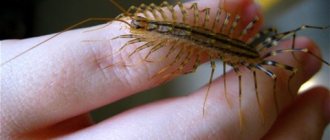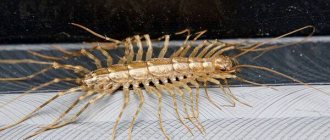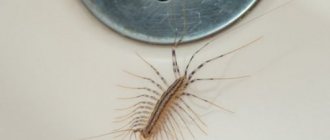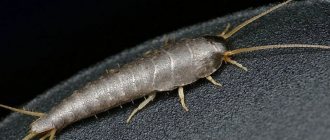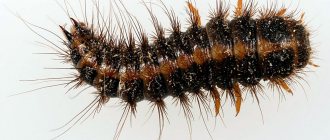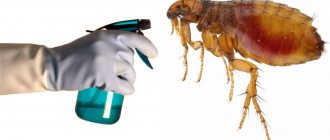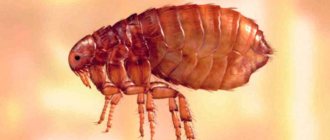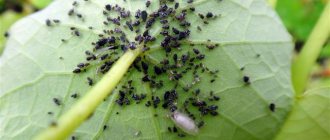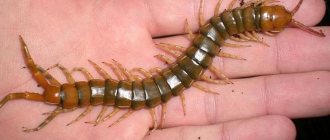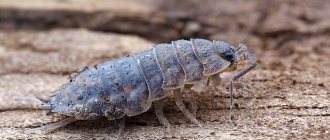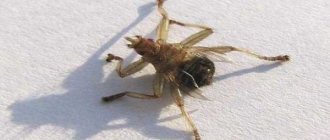- What does a centipede flycatcher look like, what kind of “beast” is it?
- How do flycatchers hunt and who do they eat?
- Centipedes in the apartment: reasons for their appearance
- Is the house centipede dangerous or not?
- How to drive away centipedes
- Harmless ways to get rid of house scolopendra
- Chemical control agents
- Centipede flytrap and traps
We are not afraid of flies, spiders, cockroaches, because we see these insects more often and are familiar with the behavior. The common house centipede flycatcher is a cautious insect, hunts at night, is rare, so the frightening appearance of the alien frightens and arouses mistrust. In addition, apartment residents do not know the habits of the unfamiliar creature or how to behave with it.
What does a centipede flycatcher look like, what kind of “beast” is it?
So, they call it: house centipede, common flycatcher, centipede, house centipede. This is not an insect, but an arthropod, breathing through tracheas.
Arthropods of the order of bipedal centipedes are divided into groups:
- Kivsyakov (forest invertebrate centipedes);
- Multilinks (blind centipedes that live everywhere);
- Armadillos (order of woodlice millipedes);
- Pauropods and symphylos (blind arthropod polypods that live in the soil);
- Labiopods (scolopendra).
The apartment from this entire set is inhabited by the common house centipede flycatcher - with a flat oblong body 3-6 cm long, light brown in color, rarely gray.
The legs and body are covered with stripes and hairs. The body of the arthropod consists of 15 segments, each with a pair of legs on the sides. A young centipede has 4 pairs of legs. An adult centipede flycatcher has 15-40 pairs of legs 3 mm each.
The last limbs are long, even exceeding the length of the body. Interestingly, a damaged or lost leg grows back. The domestic scolopendra runs 30-40 cm per second.
The whiskers are the same length as the legs, so it is easy to confuse the head with the back. With the help of antennae-catchers, which work like locators, the house centipede explores space, senses changes in environmental temperature and navigates the area.
Since the centipede insect lives in an apartment and feeds on insects, its pair of front legs has acquired the role of jaws for obtaining food in hard-to-reach places. On both sides of the head there are organs of vision that help to see in a dark room.
These inhabitants are hunted by rats and cats, which is harmful for the hunters themselves, because the house flycatchers are infected with parasites.
Centipedes are fertile: the female's clutch consists of 60 eggs protected by stickiness and hidden in a hole or crack, which the female covers with her body and legs.
The lifespan of these arthropods is 7 years and more often in one place, but they come to the apartment with the onset of cold weather. During severe cold weather, they sometimes go into suspended animation, waking up in the spring.
Preventive measures
Instead of waging war against centipedes, choosing the most effective means, it is better to take care in advance to prevent their appearance. To do this you need:
- Destroy the entire food base. If there is nothing for the flycatcher to eat in the house, it will not linger and will go to look for more favorable conditions for itself.
- Identify the source of high humidity in the room and take the necessary measures to improve the microclimate in the apartment.
- Block all routes through which these creatures get into the house. Tighten the ventilation holes with fine mesh, seal all the cracks in the floor, baseboards, and ceiling. Do not open windows and vents without a mosquito net. Check the door frame for tiny holes.
- Disassemble all the trash in the basement, pantry, attic, where the centipede could hide during the daytime and breed.
How do flycatchers hunt and who do they eat?
Flycatchers choose places with insects and beetles harmful to humans: black cockroaches, flies and fleas, moths and spiders, crickets or termites. They go hunting at night, but there are also hunters who wait for prey during the day, settling on the floor, climbing onto the ceiling or onto the wall.
They sit for hours without moving. As the prey approaches, they attack at lightning speed, neutralizing the prey by injecting poison into 2-3 insects at once. He slowly eats one dish and holds another with his legs.
Where does it come from?
Insects come in search of food from the street or from neighbors. Their favorite habitats: damp basements, underground floors, ground floors. From here, centipedes spread throughout apartments or rooms in the house. If the object is humid and the light is dim, flycatchers will settle here. Answering the question of what centipedes usually eat will help get rid of these insects. They are attracted to domestic cockroaches, flies, fleas, etc.
The centipede also lives outdoors. Outside the room it is hidden under a layer of foliage. When going in search of food, a centipede can crawl into a house. If she finds suitable living conditions for herself, including an inexhaustible source of food, she will stay here for a long time.
Clean up and the uninvited insect will disappear from the apartment
Is the house centipede dangerous or not?
The flycatcher does not harm humans. However, it should not be touched or frightened, because the centipede flytrap bites, however, only for the purpose of protection. The appearance of the centipede is frightening - the number of legs, long moving mustaches and lightning-fast movement.
Also, this arthropod does not harm furniture, wallpaper and other objects in human housing. Night hunting of creatures eliminates encounters and sometimes residents do not even know that centipedes live in the apartment.
If a bite occurs, which is unlikely, the skin turns red and a slight burning sensation is felt - cold water and hydrogen peroxide will help.
What to do if you are bitten by a scolopendra
But if you do get bitten by a scolopendra, be prepared for the following consequences (we’ll warn you right away, not fatal). The bites can be very painful and go away slowly over 1-2 days. The main symptoms that you may experience: at the very moment of the bite there will be a sharp and prolonged pain; the severity of the pain can vary (from slight to “10” on a 10-point pain scale); body temperature may increase; you may feel severe weakness; Most likely, the sensitivity of the skin in the bite area will significantly increase, swelling and redness will appear, and loss of sensitivity and a feeling of numbness may also occur.
Scolopendras are somewhat similar to wasps, which do not leave a sting in the wound and can sting a person several times in a row. Often, at the moment of detection by a person, this creature continues to inflict multiple punctures, introducing even more poison. Centipedes usually bite when a person is resting in bed, but they can also crawl into clothes and bite the moment you start getting dressed.
But there is good news: scolopendra bites are not fatal! For a person to die from its poison, he must be bitten by several thousand individuals at the same time!
Helpful advice: if you are bitten by a scolopendra, find a heating pad at home, fill it with moderately hot water (up to 45 degrees C) and apply it to the bite site - this simple measure should bring relief. Scientists have not yet found an explanation for this phenomenon, but they suspect that this is possible due to the fact that some components of scolopendra venom are unstable to heat. The second remedy is ice and analgesics.
Are centipedes dangerous for your home?
And you don’t have to worry about clothes, paper documents, furniture and other items. A centipede is not a moth or a silverfish. She is not at all interested in your things. Another thing is that some centipedes can spoil the air in the house due to the fact that they secrete a bad-smelling secretion - but even that is unlikely - there must be too many of these arthropods in your house for you to smell it. In addition, since centipedes are plant scavengers, they may become interested in rotting wood. We advise you to check attics and basements more often for moisture and for such “yummy things.”
We hope we didn't intimidate you. Therefore, at the end, in order to “whiten up” our heroes a little, let’s tell you how centipedes are useful. They are very active in destroying pests. Their diet includes bedbugs, flies, cockroaches, termites and even spiders. So sometimes centipedes turn into real “guardians of housing” from even more harmful creatures. Therefore, if you are not afraid of such many-legged neighbors, then live with them “in peace and harmony.”
Harmless ways to get rid of house scolopendra
1). Eliminate the source of moisture because flycatchers cannot live without water.
For this:
- Clean the kitchen and bathroom, clean places where a rag rarely penetrates, add bleach and chlorine to the water, do not store garbage;
- Remove wet sources (wet rags and towels, replace the bathroom rug);
- Eliminate condensation, wipe the walls and ventilate the bathroom;
- Install, if required, dryers and fans;
- Do not leave water in trays with indoor plants.
2). In a private house - clean the basement, get rid of mold and dampness.
3). If there are leaks, repair or replace leaking plumbing fixtures and pipes. Re-glue the peeling wallpaper and return the fallen tiles to their places.
4). Block the crawling paths of centipedes: fill cracks and crevices with silicone sealant, cover windows with mosquito nets, and cover ventilation ducts with fine-mesh grilles. Don't forget to clean the grates regularly.
5). Remove insects - the food of centipedes. But poisons that act on cockroaches and flies will not affect flycatchers - they develop a persistent addiction.
6). It is not difficult to remove using a humane method. Centipedes remember what happened and how they felt. With the caught animals, which were taken out and released on the street away from the house, others will also leave.
Prevention methods
The main way to protect against flycatchers is prevention:
- Clean up the area around your home. Remove fallen leaves, dry grass, and construction debris.
- Free the walls of your house from climbing plants.
- Dry the subfloor and basements. House centipedes love moisture. If the conditions are unsuitable, the insects will leave on their own to find a more comfortable place.
If you live in a city apartment, then it is important, first of all, to limit the insect’s access both from the street and from the neighboring apartment. This can be done using the following mechanical methods:
- Eliminate gaps and cracks in window frames.
- Putty the baseboards (or renew them altogether).
- Install mesh over ventilation holes.
Chemical control agents
The use of repellents or extended-spectrum insecticidal sprays, which have a high concentration, will help drive out multipedes that have multiped and come across even during daylight hours. There are no special preparations for house centipedes in the apartment.
Popular drugs:
- Aerosol Raid. Non-toxic product with lavender scent.
- Liquid Medilis-Ziper for dilution with water and spraying. It has a pungent odor and requires respiratory protection when working.
- A strong insecticide with lambda-cyhalothrin has no pungent odor and does not harm people or pets.
- Globol (odorless gel) has strong toxicity, flycatchers will not return soon.
- Great Warrior (gel) fights cockroaches and ants, but flycatchers and earwigs also do not like this product.
As a home remedy, you can sprinkle boric acid powder where centipedes run around the apartment.
Reproduction, lifespan
The process of reproduction of scolopendra takes several hours, the sacrament is carried out in the dark. The male weaves a kind of cocoon containing sperm. The female draws seminal fluid into her body. After fertilization, egg laying begins within a few weeks; in unfavorable climatic conditions, after several months. On average, a female centipede lays 130 eggs. The development of the young generation of millipedes occurs in close proximity to the female. She holds them all in her paws, dragging them everywhere with her. Small centipedes appear after 3 months. At first, the babies stay with their mother in the nest. And then the most interesting thing happens - a young female can devour her babies or the young can eat their mature mother. It was not possible to establish exactly how long scolopendras live in nature. But in captivity they can live 7 years.
Centipede flytrap and traps
Trap boxes help, but rarely. They need to be placed on the floor; insects and centipedes crawl in and stay there.
Adhesive tapes will not bring success. The centipede flycatcher will come off without sparing the remaining legs, which will later grow back.
When all else fails, they resort to the services of professionals to carry out disinfestation with chemical agents. After this, you need to leave the apartment for a walk for 4-5 hours, and when you return, open the windows for ventilation. Do not wash the floor for 2-3 days.
What kind of flies can you find in the house?
It has not yet been established exactly how many species of flies live in nature. The family of these dipterans has several hundred species. However, not all of them need proximity to humans. Among them, those living in the wild stand out, but the number of synanthropic species, at the ecological level associated with human settlements, is impressive.
Fly
Synanthropus insects pose a potential threat to human health, which is largely due to what the flies eat. According to the nature of food consumption of adults, several groups are distinguished, and in each of them the specific type of nutrition of the adults corresponds to the method of feeding of the larvae.
So, the following groups of these dipterans live near humans:
- Coprophagous - This type feeds on human and animal excrement and food waste. Plant sap is what flies feed on in nature, an additional food resource. The most common species are the grassland Muscidae and the brownie.
- Hematophagous - these dipterans in the adult stage prefer human and animal blood, sweat, blood and ichor oozing from wounds, and the larvae require excrement or decomposing animal remains and plant remains. Common representatives are the market fly and the autumn fly.
- Polyphages are insects that, as adults, feed on human excrement and food, waste, and secretions from wounds and mucous membranes. The housefly is a typical representative of this type.
House flies and house flies are the most common in homes, but pasture flies, market flies, and autumn flies also enter the house. Usually, with the onset of cold weather, insects disappear; an ambient temperature of 23 degrees Celsius is comfortable for their life.
See also: Review of the most effective fly repellent tapes
Feeding process in flies
What do flies eat? These dipterans are considered practically omnivorous. And the lack of teeth is not a hindrance. The feeding process involves a long proboscis - a kind of tongue divided into two tubes. It is through them that the food that the fly eats is absorbed.
Feeding process in flies
This is interesting, but without exaggeration these insects can be called gourmets - they do not eat everything. On the paws of an adult individual there are taste buds that allow you to taste food before the proboscis gets involved.
What do flies eat in the house? It is most convenient for insects to eat liquid food, since solid food is more difficult to eat. The indoor snack lover spends too much energy on eating and digesting it: first, solid food is abundantly moistened with saliva, and only then penetrates the digestive tract.
Typically, these dipterans are not capable of sucking human blood, but the mouthparts of the housefly, which is very similar to a housefly, are designed in a special way. The proboscis, strongly elongated and equipped with chitinous “teeth” at the end, scrapes off the epidermis by friction and lets saliva into the puncture. The zhigalka not only feeds on blood, but also leaves irritation at the site of the bite.
What foods do flies prefer?
There is what flies feed on most readily, and there is food that is used only in the absence of the preferred one. Thus, “favorite” foods include sweet foods: jam, compotes, juices, honey, etc. For the larvae to mature, flies need protein food, and here preference is given to meat, fish, etc., especially decomposing and spoiling foods.
Human housing is an ideal “dining room” for flies, and the food here is very varied. They use ready-made dishes that are not protected by lids and packaging, food waste, and when accessing the toilet (relevant for private homes), excrement. And this is not all that flies eat at home. Animal bowls, children's pots with excrement that were not removed in time, rotting fruit - all this also serves as a place for a feast.
